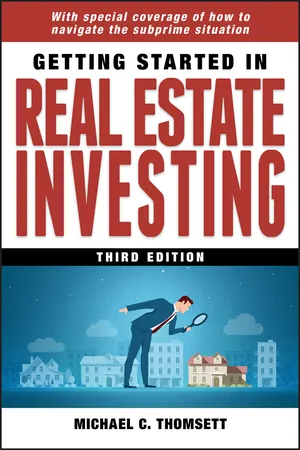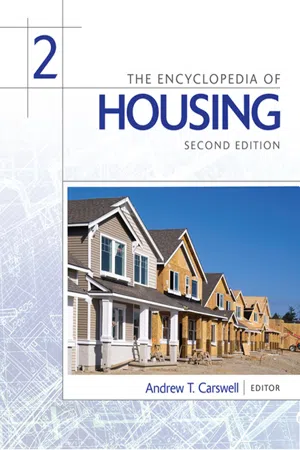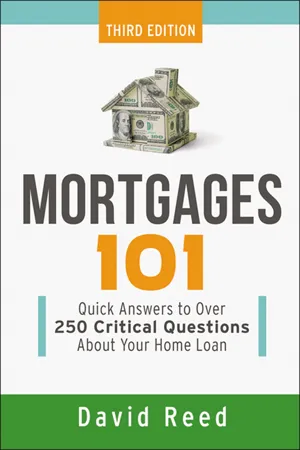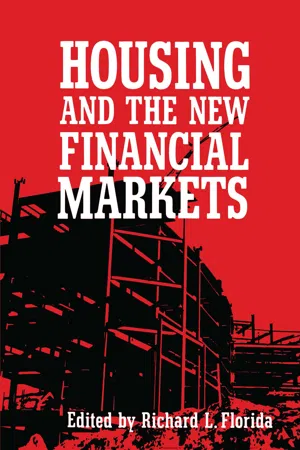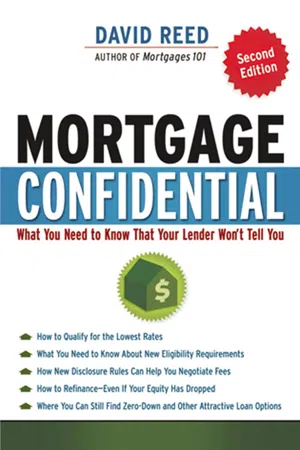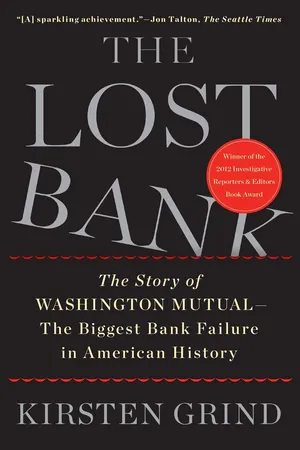Economics
Adjustable Rate Mortgage
An Adjustable Rate Mortgage (ARM) is a type of home loan with an interest rate that can change periodically. Typically, the initial interest rate is lower than that of a fixed-rate mortgage, but it can fluctuate based on market conditions. This means that the borrower's monthly payments may increase or decrease over time, depending on the terms of the loan.
Written by Perlego with AI-assistance
Related key terms
11 Key excerpts on "Adjustable Rate Mortgage"
- eBook - ePub
- Michael C. Thomsett(Author)
- 2009(Publication Date)
- Wiley(Publisher)
teaser. Later, when the adjustable feature kicked in, or when the limited time of the ARM expired, higher rates went into effect and monthly payments rose by several hundred dollars. For those who got no-down-payment deals with very low adjustable rates, it was easy to walk away from the deal. People had no equity in the properties and no way to make monthly payments. So using ARMs meant lenders caused many of their own problems.adjustable-rate mortgage (ARM)a loan for which the future interest rate may change, with the change determined by an index of rates. The frequency and amount of change are limited by the mortgage contract.Several important features come with an adjustable-rate loan. The degree to which interest will change in the future is determined by changes in an index of interest rates. Several index measurements are published, and the one the lender will use is specified in the contract. For example, some lenders adjust their rates based on auction interest rates for U.S. government securities; others use the prime rate, the bank’s district rate, or a regional rate. The important point to remember is that the index is included in the original contract; the lender cannot change the index later on.As the borrower, you take the lower initial rate as a trade-off for protection against the possibility of higher rates in the future. In other words, the risk is that your interest rate will rise; the benefit is a lower initial cost. For some borrowers, this is an acceptable risk; for others, there is no choice. Some people have to go for the adjustable-rate loan because of the initially lower monthly payment involved. To qualify for a loan, your income is compared to the monthly payment level. If the payment exceeds a predetermined standard, the bank turns you down. So to qualify when it is a close call, an adjustable-rate loan frequently makes the difference. - eBook - ePub
Booms and Busts: An Encyclopedia of Economic History from the First Stock Market Crash of 1792 to the Current Global Economic Crisis
An Encyclopedia of Economic History from the First Stock Market Crash of 1792 to the Current Global Economic Crisis
- Mehmet Odekon(Author)
- 2015(Publication Date)
- Routledge(Publisher)
Lenders can avoid this problem by offering Adjustable Rate Mortgages (ARMs), which became popular with borrowers during the housing boom of the late 2000s, as they offer lower initial monthly payments. The interest rate on an ARM is tied to an index and adjusts after a specified period of time. The lender bears less risk because the income from its assets will increase as interest rates rise. Because an ARM involves less interest rate risk for the bank, the initial interest rate is lower than the rate charged for fixed rate mortgages. The standard terms for ARMs include a periodic adjustment (annual, semi-annual, or monthly, as defined in the contract) of the interest rate that is tied to an index, such as the cost of funds index provided by the Federal Home Loan Bank, the one-year Treasury bill rate, or the London Interbank Offered Rate (known as the LIBOR). The contract rate normally equals the index rate plus a margin that is set at 150 to 275 basis points (i.e., 1.5 percent to 2.75 percent). The terms usually include a cap on the size of the annual adjustment and a cap on the total adjustment that can occur over the life of the loan. Some ARMs have an initial-period discount (“teaser” rate), during which time the initial rate is less than the index rate plus the margin. These mortgages switch to the index rate plus the margin after an initial period of two to three years. Some ARMs include a provision stipulating that the loan can be converted to a fixed rate mortgage within a certain time period (for a fee). Also, a few ARMs have a cap on the size of the monthly payment. Such a cap can lead to what is called negative amortization—the size of the outstanding loan balance increases because the monthly payment is less than the interest on the loan after adjustment.Most lenders offer a menu of mortgages that may include fixed rate mortgages with thirty-year terms, with different combinations of interest rates and discount points; fixed rate mortgages with fifteen-year terms; and Adjustable Rate Mortgages with annual interest rate adjustments and a lifetime cap. The interest rate is highest on thirty-year fixed rate mortgages, lower on fifteen-year fixed rate mortgage, and lowest on Adjustable Rate Mortgages. - eBook - ePub
- Andrew Carswell(Author)
- 2012(Publication Date)
- SAGE Publications, Inc(Publisher)
24 CFR 203.45.Adjustable Rate Mortgage (ARM), Section 251As its name suggests, an Adjustable Rate Mortgage (ARM) is called “adjustable” because the interest rate adjusts up or down depending on the rise and fall of interest rates in the market. As the interest rate is adjusted, the monthly payment is also adjusted. The initial interest rate, discount points, and margin are negotiated by the borrower and lender. Lenders are obligated to disclose all aspects of the FHA-insured ARM loan at the time of the borrower’s application. Borrowers for owner-occupied properties are eligible for the FHA-insured ARM, and applications are handled only by HUD-approved lenders.Under the FHA-insured ARM, periodic adjustment to the interest rate is based on the 1-Year Treasury Constant Maturities Index. Borrowers must be informed in advance of any adjustment to the payment. Initial interest rates may be fixed for a period of time—1, 3, 5, 7, or 10 years. After the 1- or 3-year fixed period, interest rates may not change more than 1% per year, nor may they change more than 5% over the life of the loan. For 5-year, 7-year, and 10-year fixed ARM, interest rates may adjust up to 2% annually with a 6% lifetime maximum. Regulations are at 24 CFR, 203.49.Home Equity Conversion Mortgage (HECM), Section 255Borrowers who are over age 62 may draw equity from their homes with a “reverse mortgage.” This program provides mortgage insurance and regulations that reduce lenders’ risk and provide assurances for borrowers. The conversion of home equity into cash can be as a lump sum, a stream of payments, a line of credit, or a combination of these. Each withdrawal adds to the debt, but repayment is not made until the borrower dies, moves away, or sells the home. The interest rate is adjustable, and the equity available is determined in advance based on the expected interest rate and the costs of the loan that will be charged against the equity. When the loan is due and payable, the borrower or the borrower’s heirs owe no more than the value of the property. If the mortgage balance is lower than the value, the borrower or the borrower’s heirs keep the difference. If the mortgage balance is higher than the value, the lender’s loss is covered by the FHA-HECM insurance program. Eligible borrowers must be at least 62 years of age and occupy the property as the principal residence. Preexisting liens must be small enough to be satisfied by a HECM loan advance at settlement. - eBook - ePub
- David Reed(Author)
- 2018(Publication Date)
- AMACOM(Publisher)
2. When your job has you moving a lot. Adjustable-rate mortgages typically have lower starting rates than fixed ones, and if you transfer or move often, you’ll have retired your mortgage before an adjustable has time to move upward.3. When you have a gut feeling that rates will stay the same or move lower for the long term. If your rate is in the middle of the pack compared to historic rates, an adjustable rate gives you the benefit of a lower start rate with the possibility of moving into an even lower rate later on.
There are four basics for an adjustable-rate mortgage (ARM): the index, the margin, the adjustment period, and rate caps.7.4 HOW DO ADJUSTABLE-RATE MORTGAGES WORK?1. The Index. This is what your interest rate is tied to. Your index can actually be anything you agree upon, but most ARMs are indexed to a one-year treasury, or something called a LIBOR. LIBOR stands for the London Interbank Offered Rate, and this index is quite similar to the Federal Funds rate found here in the United States. The LIBOR index is released each business day and is the index by which banks lend money to one another over the short term—for example, overnight.The one-year treasury is a security or treasury bill issued by the Fed to, among other things, raise money. Other indexes that ARMs might be tied to are various LIBOR and treasury maturities, like one-month or six-month LIBOR ARMs; the prime rate; or even certificates of deposit (CDs). Your index could theoretically be anything you agree to. It could be the price of a gallon of ice cream if that’s the deal you come up with. Just don’t bet the lender will use ice cream as your index; lenders will use one of the indexes mentioned above.2. The Margin. The margin is the difference between your mortgage rate and your index. The index is what your rate is based upon, and the lender adds a margin to it (think profit margin or cushion) to arrive at your fully indexed rate - eBook - ePub
- Richard L. Florida(Author)
- 2019(Publication Date)
- Routledge(Publisher)
Alternative mortgage instruments are designed to accommodate the new needs of both mortgage borrowers and lenders. Because the problems of borrowers and lenders differ, the mortgage plan best suited to one may not be the one best suited to the other. Risk averse mortgage lenders would benefit most from mortgages whose rates fluctuate closely with their cost of deposits, while younger mortgage borrowers stand to gain from mortgages whose initial monthly payments are low relative to their incomes. Unfortunately, these two objectives are not always mutually consistent. Mortgage plans with increased rate volatility may not reduce early monthly payments and will transfer interest risk from the lending institution to the borrower, who is often less willing and able to assume it. Mortgage plans with lower initial monthly payments need not increase rate flexibility and could result in monthly payments to the depository institution smaller than necessary to cover the monthly interest cost of the loan. Any shortfall would be added to the principal of the loan in the form of negative amortization and, by increasing the unpaid balance of the loan, would increase the risk of default. The increase in default risk may offset part or all of the benefit to the lender of the decline in interest rate risk from rate flexibility. The following sections describe a number of “alternative” mortgage plans, either already in use or proposed, and their advantages and disadvantages to lenders and borrowers.Adjustable-Rate Mortgages
Adjustable-rate mortgages (ARMs), as their name implies, are mortgage plans whose contract or coupon interest rates change periodically after origination according to some agreed-upon conditions. Pure ARMs, that is, ARMs without any restrictions on rate changes, would eliminate the lending institution’s interest rate exposure completely if the loan rate changed immediately everytime the deposit rate changed and by exactly the same amount.2 The change in the cost of funds effectively would be passed through to the mortgage borrower and not impact the institution at all. All the risk of unfavorable interest rate changes that was borne by the lender under fixed-rate mortgages (FRMs) would now be borne by the borrower. The institution would be freed of any need to forecast interest rates in order to price its mortgages correctly.3But the ARM is not costless to either lender or borrower. Although mortgage lending institutions incurred risk in making long-term, fixed-rate mortgages, they charged a premium for this service which until recent years was sufficiently high to make this activity profitable. If the institutions eliminate this risk, they will also eliminate a line of business that could again be potentially profitable. Financial institutions, which are in the business of dealing with interest rate changes every day and are by nature familiar with finance and economics, may be expected to be better situated than individual households to make meaningful interest rate predictions and assume interest rate risk. Although household mortgage borrowers would benefit from ARMs if interest rates were to fall, many tend to be risk averse, putting greater weight on interest rate increases than decreases of the same magnitude. They are generally willing to pay some premium to insure themselves against the possibility of paying unexpectedly higher rates during the life of the mortgage. This is so even though the average borrower’s income rises with the interest-rate as might be expected if market rates incorporate a premium for expected inflation. - eBook - ePub
- David Reed(Author)
- 2010(Publication Date)
- AMACOM(Publisher)
CHAPTER 7 Loan ChoicesI worked in the mortgage lending division of a major bank for several years, and each day the bank’s secondary department would distribute its daily rate sheets—all eight pages of them, with each page having about 15 different loan programs with different available rates. That’s a lot of loan programs—in fact, a little too many, in my opinion. But in the world of marketing, it’s all about distinguishing yourself.CONFIDENTIAL: There Are Really Only Two Types of Loan: Fixed and Adjustable.That’s it. There’s not a lot more to it other than lenders offering different variations on a fixed-rate loan and an adjustable-rate loan. Fixed-rate loans can have terms as short as 10 years or all the way out to 40 years—or longer.Adjustable-rate mortgages, on the other hand, can be based on a variety of indexes, some of which you may have heard of and some not. Adjustable rates are set using an index and a margin. There is a third category of loan program called a hybrid, but it’s really not all that different.A hybrid is actually an adjustable-rate mortgage with special terms attached.The rates on adjustable-rate mortgages, or ARMs, can change. That’s why they’re called adjustable. Fortunately, however, you’re aware of what those changes can be. An ARM is first based upon an index, the starting point for how your monthly payments will be calculated.The most common indexes are the one-year Treasury index and LIBOR. The Treasury index is the one-year Treasury note issued by the U.S. government. LIBOR stands for London Interbank Offered Rate; it is similar to our fed funds and discount rates. Next, the margin is added to the index to give the interest rate on which the consumer’s mortgage payment is based.If the index is 4.5 and the margin is 2.75, then the interest rate would adjust to 4.5 + 2.75,or 7.25 percent. This is also called the fully indexed rate. On a loan amount of $200,000, the monthly payment would be $1,364. - eBook - ePub
AARP Master Your Debt
Slash Your Monthly Payments and Become Debt Free
- Jordan E. Goodman(Author)
- 2011(Publication Date)
- Wiley(Publisher)
Amortization. Some ARMs are not calculated to pay off over time; instead, they will leave you at the end of the mortgage with a balloon payment due. For example, the payments may be amortized over 30 years, but the loan is due in 10. That’s dangerous. You have no idea what the mortgage market will be like then, when you’ll have to replace your loan.• The payment. Some ARMs also will cap your monthly payment, and defer increasing it over a preset level, even if interest rates go up. That’s dangerous, too. You could end up never repaying your mortgage under those terms.• The index. Different ARMs are linked to different interest rate indexes. They used to be linked to rates on Treasury bills and one-year Treasuries, but they are increasingly linked to the London Interbank Offered Rate (LIBOR). That is a very volatile index, and could cause the rate on your loan to jump around a bit.• The rules governing when the rate is reset. Typically this happens once a year, but it can happen more often.• The period before rates are reset. Some ARMs offer as long as 10 years before the rate resets. Five years is more typical; some require adjustments annually.The ArcLoan—One Variable-Rate Loan That I Like
It may seem strange, after that last section, to admit that I have a variable-rate mortgage for my own house. But here’s why: I have a variable-rate mortgage that can only go down, not up. It’s called an ArcLoan, or automatic rate cut mortgage. I got my mortgage in February 2001 and the rate has fallen seven times since then.Here’s the concept behind it: Most mortgage lenders don’t really want to lose customers when rates fall. By getting pre-agreement from the lenders to limit and then cover refinancing closing costs, ArcLoan customers are able to refinance whenever rates drop. The bankers win, because they keep their customers. The customers win, because they can take advantage of lower and lower rates without worrying about rate hikes, and without having to shop for new lenders every time rates fall. - eBook - ePub
Fixed Income Securities
Concepts and Applications
- Sunil Kumar Parameswaran(Author)
- 2019(Publication Date)
- De Gruyter(Publisher)
Most lenders charge a lower interest rate for an ARM at the outset, as compared to a fixed-rate mortgage. Thus the initial financial burden on the new homeowner is lower. If rates do not change much, or decline sharply, the borrower stands to benefit as compared to a party who has availed of a fixed rate mortgage. However, the flip side is that the interest rates may rise, and the borrower then has to pay higher periodic installments.The interest rate and consequently the monthly payment of an ARM resets periodically. The rate may change every month, quarter, year, or even longer periods. The time period between rate changes is called the adjustment period. For instance, an ARM may have an adjustment period of 12 months. That is, the rate is reset once per annum.Variations on the ARM Structure
Let’s now discuss some alternatives to a simple ARM structure.Hybrid ARMs: An N/1 ARM is a hybrid of a fixed rate and a variable rate mortgage loan. The rate remains fixed for the first N years, after which the loan assumes the feature of an Adjustable Rate Mortgage. For instance, a 5/1 ARM means that the rate is fixed for the first five years. Thereafter the rate adjusts annually until the loan is paid off. A 30 mortgage loan may also be described as an n/30-n ARM, for instance a 4/26 ARM. This means that the rate remains fixed for the first four years, after which it becomes adjustable. Once the fixed rate period expires, the rate may be adjusted annually or at times even more frequently.Interest-only or I-O ARMs: In the case of such an ARM, the borrower pays only interest for the first few years. This reduces the cash flow burden on the borrower. At the end of the initial period, the monthly payments increase, even if interest rates do not change, because the entire principal has to be repaid over a truncated period. The interest rate may or may not adjust during the initial (I-O) period. The longer the duration of the I-O period, the higher the periodic payment is after it ends, because the loan has to be repaid during a shorter period. Example 8.4 - eBook - ePub
Managing Financial Institutions
Markets and Sustainable Finance
- Elizabeth S. Cooperman(Author)
- 2016(Publication Date)
- Routledge(Publisher)
The amount a homeowner can borrow for a second mortgage loan is limited to the amount of equity they have accumulated in their homes. A home equity loan, however, is a revolving line of credit against which a homeowner can borrow with the loan maximum allowed as 70−85% of the equity the borrower has in the home. Since the lender has the security of a junior lien on the borrower’s home in the event of default, HELs are offered at lower interest rates than credit card or unsecured consumer loans. Interest rates are variable (sometimes changing monthly) and are often tied to movements in base rates such as a prime rate or T-bill rate index. Repayment schedules are more flexible than second mortgages, and the borrower may often draw on unused but approved credit limits by writing a check. In the United States, the Competitive Equality Banking Act (CEBA) of 1987 mandates that HELs must have lifetime interest rate caps. The Home Equity Loan Consumer Protection Act of 1988 specifies rigid disclosure rules and restricts the right of creditors to charge loan terms after a home equity loan has been approved. Special Considerations of Mortgage Loans Adjustable Rate Mortgages (ARMs) There are many special regulations for mortgage loans including Adjustable Rate Mortgage loans (ARMs), such as the indexes that can be used. The lender must explain to the borrower exactly how the loan interest rate is related to the index and how it will be adjusted as the index changes. A 15-year history of the index must be provided. Banks also have limits called caps on the size of the periodic rate adjustment, with an overall cap required by federal law in the United States. Federal regulations prohibit prepayment penalties on ARMs. Convertible ARMs have been developed whereby borrowers can switch ARMs to fixed-rate mortgages (FRMs) during a specified period. Many loan customers prefer ARMs because they offer lower rates than FRMs, since the borrower takes on the interest rate risk - eBook - ePub
Structured Finance
Leveraged Buyouts, Project Finance, Asset Finance and Securitization
- Charles-Henri Larreur(Author)
- 2021(Publication Date)
- Wiley(Publisher)
In 2004, the US Department of Housing and Urban Development revised upwards the targets set in 1997, creating a new cash inflow towards subprime borrowers. The decision was positive for low‐income US citizens but was only made possible by the weakening of Fannie Mae's and Freddie Mac's credit profile. The situation, however, did not really seem to be an issue, as both institutions benefitted from a guarantee from the US government. It even looked like a very positive step as the two companies had very low funding rates (due to the guarantee of the Federal State) but were recording high profits thanks to the hefty interest rates charged to poor families.Negative Amortization Adjustable Rate Mortgages
The growing US real estate bubble was also characterized by the generalization of very aggressive loan structures. From the mid‐2000s onwards, banks only rarely required down payments from clients for buying a house. Households with extremely limited resources could borrow amounts equal to the value of the property they wanted to buy. In many cases, loans were even granted for a higher amount as they covered all costs incurred by the acquisition of a property: taxes, registration fees, and refurbishment works. This situation created de facto for banks an additional level of risk as they accepted weaker security packages. In case of default of their clients and foreclosure and sale of a property, they did not benefit from any buffer to minimize their loss.Some even more aggressive types of loans were offered to customers, especially to the poorest households. Banks proposed loans that gave the possibility to defer for two years the repayment of the principal and a large part of the interest. For extremely modest households (i.e. subprime borrowers), these negative‐amortizing adjustable‐rate mortgages (ARMs) were extremely attractive. They offered the opportunity of becoming a home owner rapidly without a down payment and without paying much during the first two years.From 2005 onwards, these ARMs became the norm in the subprime lending segment. A household with limited resources could borrow a large amount of funds over a long period. Only a small part of the interest was due during the first two years. The deferred interest was added to the principal amount of the loan, to be paid later. - eBook - ePub
The Lost Bank
The Story of Washington Mutual-The Biggest Bank Failure in American History
- Kirsten Grind(Author)
- 2012(Publication Date)
- Simon & Schuster(Publisher)
An entire country of lenders had shifted toward short-term lending, a change blessed by Federal Reserve chair Alan Greenspan in, oddly, a meeting of the Credit Union National Association. Credit unions had steered clear of offering unusual mortgage products, in part because their charters prevented them from doing so. “Homeowners clearly like the certainty of fixed mortgage payments,” Greenspan told the group of credit unions. 19 But, he added, homeowners “might have saved tens of thousands of dollars had they held adjustable-rate mortgages rather than fixed-rate mortgages during the past decade.” “American consumers might benefit if lenders provided greater mortgage-product alternatives to the traditional fixed-rate mortgage,” Greenspan said, without suggesting specifics. * A national survey came out, revealing that a third of Americans who had purchased a home in the last several years used some kind of “creative mortgage option,” such as an interest-only payment option, or miss-a-payment mortgage. (That last choice wasn’t offered by WaMu.) Of the homeowners surveyed, one in five had bought a home that was considered out of his price range. Some banks began offering Option ARMs or other adjustable-rate mortgages for the first time. Others, like WaMu, simply turbocharged their existing product line. IndyMac, a midsize California mortgage lender, shifted its mortgage product mix just as WaMu did, cutting its prime loans and doubling its adjustable-rate volume, including Option ARMs. 20 Golden West Financial, another California-based lender operating as World Savings Bank, made Option ARMs almost exclusively. The company’s $119 billion loan portfolio had increased as, the bank noted in its 2005 annual report, “there has been an industry-wide increase in the origination of option ARMs, our principal mortgage product for the past twenty-five years
Learn about this page
Index pages curate the most relevant extracts from our library of academic textbooks. They’ve been created using an in-house natural language model (NLM), each adding context and meaning to key research topics.
